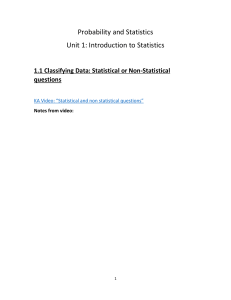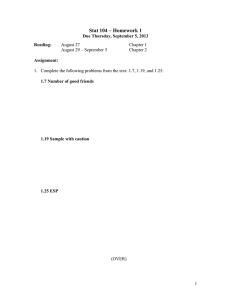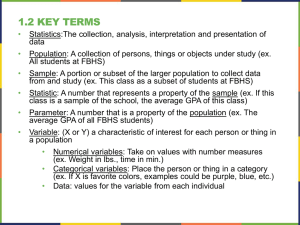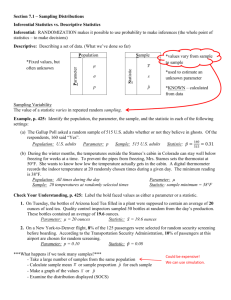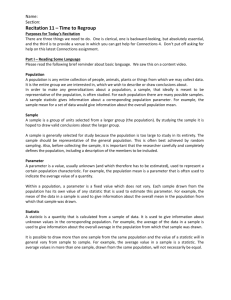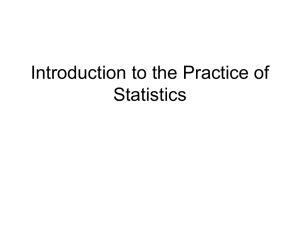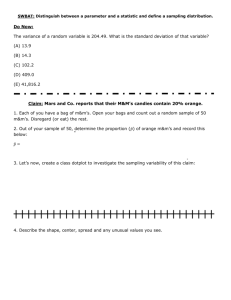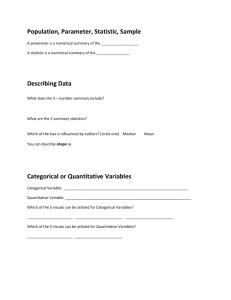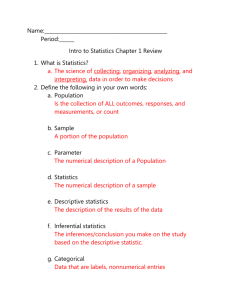Unit 1 Stats
advertisement
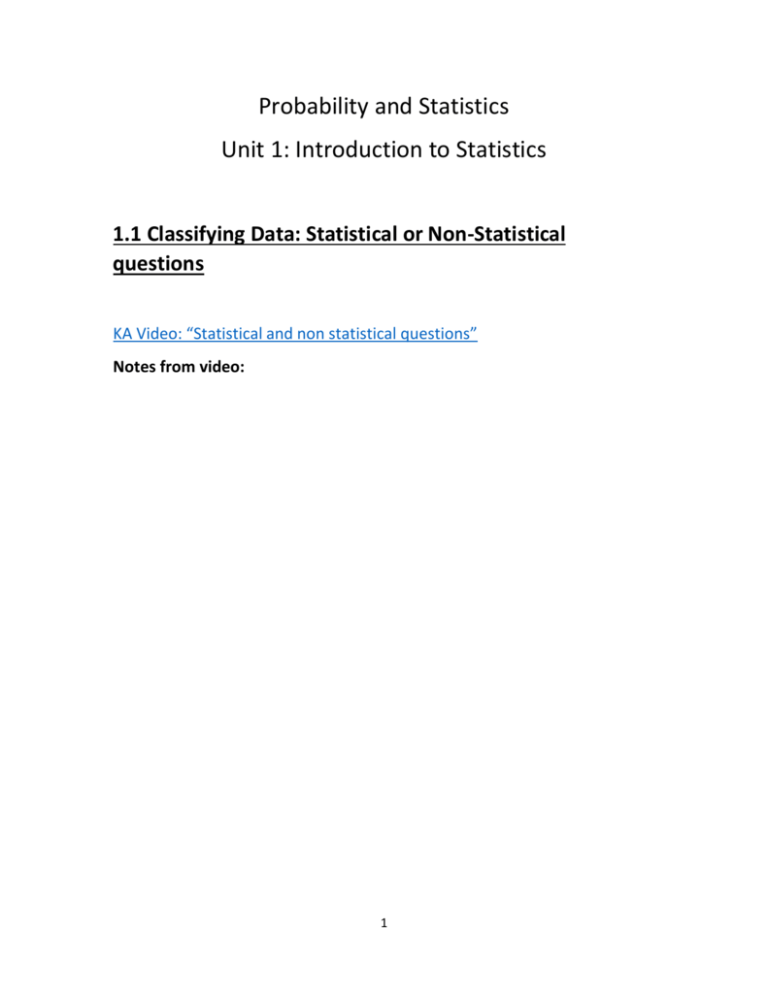
Probability and Statistics Unit 1: Introduction to Statistics 1.1 Classifying Data: Statistical or Non-Statistical questions KA Video: “Statistical and non statistical questions” Notes from video: 1 Practice: Determine whether the following is a statistical question: 1. How many internet searches do residents at Rudolph's Retirement Home perform each day? 2. What is the volume of water in Captain Flush's toilet? 3. What is the average height of dog kennels at Keita's Kennels? 4. What is the distance between Edfred's eyes? 5. On average, how many steps does Rahul take in a day? 6. Did Jose watch television last night? 7. How many teeth does Edna have in her mouth? 8. What is the distance between Madison, Wisconsin and Raleigh, North Carolina? 9. Does Miranda have a college degree? 10. How many hairs are there in Gretchen the Gorilla's right armpit? 11. How many text messages have you sent today? 12. What percent of players on the Arctic Kangaroos football team weigh more than 100 kilograms? 13. At colleges in Jacksonville, do tennis coaches generally get paid more than football coaches? 14. What is the length of the big toe on Sal's right foot? 15. How much does Smarto the Baby Elephant weigh? 16. At the Minnesota Zoo, do spider monkeys typically weigh more than owl monkeys? 17. In general, how many donuts do baby giraffes eat in a day? 18. How many acorns do squirrels typically eat in a day? 2 19. How much time do seniors at Eastview High School spend clipping their toe nails? 20. How many boogers does Karissa the ogre have in her left nostril? 21. What is the average area of an elephant's left ear? 22. Does it typically rain more in the United States or in Brazil? 23. In general, how tall are giraffes? 1.2 Classifying Data: Parameter vs Statistic KA Video: “Inferring population mean from sample mean” Notes from video: 3 4 Practice: For 1-4, determine whether the underlined value is a parameter or a statistic. 1. In a national survey on substance abuse, 10% of respondents aged 12 to 17 reported using illicit drugs within the past month. 2. Ty Cobb is one of major league baseball’s greatest hitters of all time, with a career batting average of 0.366. 3. A study of 6076 adults in public rest rooms (in Atlanta, Chicago, New York City, and San Francisco) found that 23% did not wash their hands before exiting. 4. Interview of 100 adults 18 years of age or older, conducted nationwide, found that 44% could state the minimum age required for the office of US president. 5. The mean income of all subscribers to a particular magazine is $26000. We draw a random sample of 100 subscribers and find that their mean income is $27300. Identify the (a) population: (b) sample: (c) parameter: (d) statistic: 6. The average GPA for all female volleyball players in a particular college is 2.8, and their mean height is 182cm. Identify the parameter or statistic if there is any. (a) parameter: 5 (b) statistic: 7. Identify the population and the sample: a) A survey of 1353 American households found that 18% of the households own a computer. b) A recent survey of 2625 elementary school children found that 28% of the children could be classified obese. c) The average weight of every sixth person entering the mall within 3 hour period was 146 lb. 8. Determine whether the numerical value is a parameter or a statistics (and explain): a) A recent survey by the alumni of a major university indicated that the average salary of 10,000 of its 300,000 graduates was 125,000. b) The average salary of all assembly-line employees at a certain car manufacturer is $33,000. c) The average late fee for 360 credit card holders was found to be $56.75. 9. For the studies described, identify the population, sample, population parameters, and sample statistics: a) In a USA Today Internet poll, readers responded voluntarily to the question “Do you consume at least one caffeinated beverage every day?” b) Astronomers typically determine the distance to galaxy (a galaxy is a huge 6 collection of billions of stars) by measuring the distances to just a few stars within it and taking the mean (average) of these distance measurements. 10. A beverage company wanted to see if people in the United States liked their new logo. Which choice best represents a population? A. A selection of logo artists. B. Every person in the United States. C. A selection of shoppers from different states. D. 3,800 children age 5 – 15 11. A musician wanted to see what people who bought his last album thought about the songs. Which choice best represents a sample? A. Every person who bought the album. B. A selection of people who didn't want to buy the album. C. 250 girls who bought the album. D. A selection of 3,294 people who bought the album. 12. A gaming website wanted to find out which console its visitors owned. Which choice best represents a population? A. Visitors to the 3DS section. B. All of the website visitors. C. Visitors to the PS4 section. D. Visitors who are on the website for more than 5 minutes. 13. Before a nation wide election, a polling place was trying to see who would win. Which choice best represents a sample? 7 A. A selection of voters over age 50. B. A selection of male voters. C. A selection of voters of different ages. D. All voters. 14. A mayor wanted to see if the people in his town thought he was doing a good job. Which choice best represents a sample? A. 1,000 unemployed voters. B. The mayor's family. C. The residents of the town. D. 242 voters. 15. A toy store owner tracking how much kids spend each month on toys. Which choice best represents a population? A. All of the kids who buy toys. B. 227 rich kids. C. 228 boys age 7 - 15 D. 235 kids from age 10 to 15. 16. What are all members of a specified group? 17. 68% of students out of 1000 surveyed planned to go to college right after high school. What is the percent of all students who plan to go to college right after high school.? A parameter or a statistic and why? 8 18. In a sample of 1200 students, 73% did not like tests. What is the percent of all students who do not like tests? A parameter or a statistic and why? 19. A study was done which found that 78% of 1000 students surveyed were overweight. What is the percent of all students who are overweight? A parameter or a statistic and why? 20. In a sample of 1200 students, 62% did not like tests. What is 62%? A parameter or a statistic and why? 21. Suppose a UK student, we’ll call him George, wants to conduct a survey about Kentucky High School students and hands out his survey to high school students at Lexington Catholic, Henry Clay, and Paul Laurence Dunbar. From a study in 2005, it was already known that 82% of high school students in Kentucky said they were going to apply to go to college. George’s survey revealed that 64% of the students were going to apply to go to college. George used the information from his survey to determine that at least 60% of high school students in Kentucky were going to apply to go to college. Identify the following… Population Sample Parameter Statistic 9 1.3 Classifying Data: Quantitative and Qualitative data YT Video: https://youtu.be/EcKrT_IegoU Notes from video: 10 11 Practice: Qualitative vs. Quantitative Identify Data Types Suppose that you are a biologist studying elephants in their natural habitat in Africa. You observe their behaviors and interaction, and take photographs of their interactions to study later. Examine the photograph of the elephants shown above. 12 1. Give two examples of qualitative data that could be obtained from the photograph of the elephants. 2. Give two examples of quantitative data that could be obtained from the photograph of the elephants. Qualitative vs. Quantitative Sorting Activity 1. Cut out the data below. 2. Decide whether the data is qualitative or quantitative. 3. Sort and paste the data on the chart provided 13 The gummy worm increased by 2 inches. The birds were young. The rock sample consisted of 25 grams of quartz There were four dogs in the group. The dogs were small. The rock sample was reddish brownish. The sample contained 3 different types of bacteria. The sample with the baking soda appeared bubbly The patient complained of aches and pains. The leaves on the first plant specimen appeared healthier. The patient had a temperature 102 degrees. The first plant specimen had 3 more leaves than the second specimen. The chimp identified 12 pictures correctly. The leaves on the second plant specimen were green, while the leaves on the first plant specimen were turning brown. The parrots range from bright green to dark red. The balloon increased in size from 5 inches to 8 inches around. 14 Qualitative Quantitative 15 1.4 Data Collection: Sampling Techniques YT Video: https://youtu.be/-pNEI1oe7CY Notes from video: 16 Project (Statistical Samples): 1. Acting as your school’s census bureau, identify a characteristic of interest or importance to your school and choose a survey question. (Topic examples: transportation to and from school, team sports or other extracurricular activities, foreign languages studied, etc.) For some of these topics, you may be able to check the accuracy of your survey results against actual tallies your school keeps. Be sure not to ask questions about attitudes or opinions. Write your topic and survey question here: ___________________________________________________________________ ___________________________________________________________________ ___________________________________________________________________ 2. Choose your target population. The target population is the group of people to whom you want the sample survey to apply. For instance, a survey about a school-related question could apply to the students in your grade or to the whole student body. Make sure you survey a good sample of your target population. (For example, if your survey applies to a student body of 400, you might want to talk to at least 10%, or 40 people.) Write your target population and sample size here: ___________________________________________________________________ ___________________________________________________________________ ___________________________________________________________________ 3. Based upon the steps above, which sampling method would you choose for your survey? Why? ___________________________________________________________________ ___________________________________________________________________ ___________________________________________________________________ ___________________________________________________________________ ___________________________________________________________________ ___________________________________________________________________ 4. Now conduct your sample survey and tabulate the results. Then organize your results into a graph or table and add a narrative summary. 17
